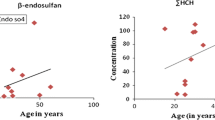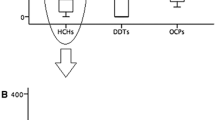Abstract
The content of organochlorine pesticides in blood of residents of the Russian Far East is assessed. Among hexachlorocyclohexane isomers, only β-HCH has been found. This fact indicates that contamination of the environment and human organisms by this pesticide began long ago. Its concentration varies from 2060 to 22,230 ng/g lipid. The probable sources of the toxicant found in human organisms are discussed.
Similar content being viewed by others
References
Burke ER, Holden AJ, Shaw IC (2003) A method to determine residue levels of persistent organochlorine pesticides in human milk from Indonesian women. Chemosphere 50:529–535
Campoy C, Olea-Serrano F, Jiménez M, Bayés R, Cañabate F et al (2001) Diet and organochlorine contaminants in women of reproductive age under 40 years old. Early Hum Dev 65:S173–S182
Chikuni O, Nhachi CFB, Nyazema NZ, Polder A, Nafstad I et al (1997) Assessment of environmental pollution by PCBs, DDT and its metabolites using human milk of mothers in Zimbabwe. Sci Total Environ 199:183–190
Dirtu AC, Cernat R, Dragan D, Mocanu R, Van Grieken R et al (2006) Organohalogenated pollutants in human serum from Iassy, Romania and their relation with age and gender. Environ Int 32:797–803
Fleming L, Mann JB, Bean J, Briggle T, Sanchez-Ramos JR (1994) Parkinson’s disease and brain levels of organochlorine pesticides. Ann Neurol 36:100–103
Foster WG, Hughes CL, Chan S, Platt L (2002) Human developmental exposure to endocrine active compounds. Environ Toxicol Pharmacol 12:75–81
Fukata H, Omori M, Osada H, Todaka E, Mori C (2005) Necessity to measure PCBs and organochlorine pesticide concentrations in human umbilical cords for fetal exposure assessment. Environ Health Perspect 113:297–303
Glynn AW, Wolk A, Aune M, Atuma S, Zettermark S et al (2000) Serum concentrations of organochlorines in men: a search for markers of exposure. Sci Total Environ 263:197–208
Loffler G, Van Bavel B (2000) Potential pathways and exposure to explain the human body burden of organochlorine compounds: a multivariate statistical analysis of human monitoring in Würzburg, Germany. Chemosphere 40:1075–1082
Longnecker MP, Klebanoff MA, Zhou H, Brock JW (2001) Association between maternal serum concentration of the DDT metabolite DDE and preterm and small-for-gestational-age babies at birth. Lancet 358:110–114
Lukyanova ON, Tsygankov VY, Boyarova MD, Khristoforova NK (2014) Pesticide biotransport by Pacific Salmon in the Northwestern Pacific Ocean. Dokl Biol Sci 456:188–190
Muir DCG, Grift NP, Lockhart WL et al (1995) Organochlorine concentration in Arctic marine mammals. Sci Tot Environ 447:160–161
Nakata H, Kawazoe M, Arizono K, Abe S, Kitano T et al (2002) Organochlorine pesticides and polychlorinated biphenyl residues in foodstuffs and human tissues from China: status of contamination, historical trend, and human dietary exposure. Arch Environ Contam Toxicol 43:473–480
Nasir K, Bilto YY, Al-Shuraiki Y (1998) Residues of chlorinated hydrocarbon insecticides in human milk of Jordanian women. Environ Pollut 99:141–148
Nicholson WJ, Landrigan PJ (1994) Human health effects of polychlorinated biphenyls. In: Schecter A (ed) Dioxins and Health. Plenum Press, New York, pp 487–525
Palanza P, Morellini F, Parmigiani S, vom Saal F (1999) Prenatal exposure to endocrine disrupting chemicals: effects on behavioral development. Neurosci Biobehav Rev 23:1011–1027
Polder A, Odland JO, Tkachev A, Føreid S, Savinova TN et al (2003) Geographic variation of chlorinated pesticides, toxaphenes and PCBs in human milk from sub-arctic and arctic locations in Russia. Sci Total Environ 306:179–195
Porta M, de Basea MB, Benavides FG, Lopez T, Fernandez E et al (2008) Differences in serum concentrations of organochlorine compounds by occupational social class in pancreatic cancer. Environ Res 108:370–379
Ribas-Fito N, Torrent M, Carrizo D, Munoz-Ortiz L, Julvez J, Grimalt JO, Sunyer J (2006) In utero exposure to background concentrations of DDT and cognitive functioning among preschoolers. Am J Epidemiol 164:955–962
Roberts EM, English PB, Grether JK, Windham GC, Somberg L, Wolff C (2007) Maternal residence near agricultural pesticide applications and autism spectrum disorders among children in the California Central Valley. Environ Health Perspect 115:1482–1489
Schaefer WR, Hermann T, Meinhold-Heerlein I, Deppert WR, Zahradnik HP (2000) Exposure of human endometrium to environmental estrogens, antiandrogens, and organochlorine compounds. Fertil Steril 74:558–563
Stuetz W, Prapamontol T, Erhardt J, Classen H (2001) Organochlorine pesticide residues in human milk of a Hmong hill tribe living in Northern Thailand. Sci Total Environ 273:53–60
Tanabe S (2000) Asian developing regions: persistent organic pollutants in seas. In: Sheppard CRC (ed) Sea at the millennium: an environmental evaluation. Elsevier Science, Amsterdam, pp 447–462
Tanabe S, Subramanian A (2006) Bioindicators of POPs: monitoring in developing countries. Kyoto University Press. Trans Pacific Press, Kyoto, 190 p
Thomas GO, Wilkinson M, Hodson S, Jones KC (2006) Organohalogen chemicals in human blood from the United Kingdom. Environ Pollut 141:30–41
Tsygankov VY, Boyarova MD (2015) Sample preparation method for the determination of organochlorine pesticides in aquatic organisms by gas chromatography. Achiev Life Sci. doi:10.1016/j.als.2015.05.010
Tsygankov VY, Boyarova MD, Lukyanova ON (2014) Persistent toxic substances in the muscles and liver of the Pacific Walrus Odobenus rosmarus divergens Illiger, 1815 from the Bering Sea. Russ J Mar Biol 40(2):147–151
Waliszewski SM, Caba M, Herrero-Mercado M, Saldariaga-Norena H, Meza E et al (2012) Organochlorine pesticide residue levels in blood serum of inhabitants from Veracruz. Mexico Environ Monit Assess 184:5613–5621
Wang H-S, Chen Z-J, Wei W, Man Y-B, Giesy JP et al (2013) Concentrations of organochlorine pesticides (OCPs) in human blood plasma from Hong Kong: markers of exposure and sources from fish. Environ Int 54:18–25
Acknowledgments
Collection of the material was supported financially by Genzo Shimadzu’s Grant (2014–2015). The study of the material was supported financially by the Russian Scientific Fund (no. 14-50-00034).
Author information
Authors and Affiliations
Corresponding author
Additional information
Responsible editor: Ester Heath
Rights and permissions
About this article
Cite this article
Tsygankov, V.Y., Boyarova, M.D., Kiku, P.F. et al. Hexachlorocyclohexane (HCH) in human blood in the south of the Russian Far East. Environ Sci Pollut Res 22, 14379–14382 (2015). https://doi.org/10.1007/s11356-015-4951-3
Received:
Accepted:
Published:
Issue Date:
DOI: https://doi.org/10.1007/s11356-015-4951-3




